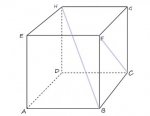You are using an out of date browser. It may not display this or other websites correctly.
You should upgrade or use an alternative browser.
You should upgrade or use an alternative browser.
Geometry help
- Thread starter Starlight
- Start date
D
Deleted member 4993
Guest
Are you allowed to use vector?Hi! I'm having a bit of difficulty in solving a problem and I'd love to hear any suggestions.
The question is: "What is the measure of the angle between HB and FC?"
Thank you!
View attachment 10555
pka
Elite Member
- Joined
- Jan 29, 2005
- Messages
- 11,990
Because the lines \(\displaystyle \overleftrightarrow {HB}~\&~\overleftrightarrow {FC}\) are skew technically there is no angle between the line segments. However informally if \(\displaystyle \overline{FC}\) could be projected onto \(\displaystyle \overline{HB}\) it is possible to answer your question. Hence Mr. Kahn's question. Both of those skew lines has a direction vector. The angle between those two direction vectors could (very very informally) be called the angle you seek.Hi! I'm having a bit of difficulty in solving a problem and I'd love to hear any suggestions.
The question is: "What is the measure of the angle between HB and FC?"
Thank you!
View attachment 10555
Dr.Peterson
Elite Member
- Joined
- Nov 12, 2017
- Messages
- 16,854
Hi! I'm having a bit of difficulty in solving a problem and I'd love to hear any suggestions.
The question is: "What is the measure of the angle between HB and FC?"
Thank you!
View attachment 10555
We'll define the angle between skew lines to be the angle(s) between any pair of intersecting lines parallel to them.
If you don't know about vectors, you could consider a line segment HK parallel to FC (that is, translate segment FC so that F goes to H), and apply trigonometry to triangle HKB. There are several reasonable alternatives. But vectors are almost certainly easier.
pka
Elite Member
- Joined
- Jan 29, 2005
- Messages
- 11,990
I fail to see a \(\displaystyle K\) in the diagram. Is that a typo? Hey DR. P can you tell us of a recognized text that defines an angle between to skew lines ?We'll define the angle between skew lines to be the angle(s) between any pair of intersecting lines parallel to them. If you don't know about vectors, you could consider a line segment HK parallel to FC (that is, translate segment FC so that F goes to H), and apply trigonometry to triangle HKB. There are several reasonable alternatives. But vectors are almost certainly easier.
Dr.Peterson
Elite Member
- Joined
- Nov 12, 2017
- Messages
- 16,854
I fail to see a \(\displaystyle K\) in the diagram. Is that a typo? Hey DR. P can you tell us of a recognized text that defines an angle between to skew lines ?
I implicitly defined K by construction. It's only in my diagram.
I explicitly said "We'll define the angle ...", not "The angle is defined as ..." because I AGREE with you that this is not standard. I had the same initial reaction as you; the only reason I didn't say it is that you already had!
We can, nevertheless, see what definition makes sense; and what I suggested agrees with your suggestion.
I did a search for a reputable source for such a definition and didn't find one (though I did find sources); if I had, I would have included a link. (The best I found was this. Here is another source. Here and here are two book references. I don't know what makes a text "recognized"; I don't recognize these ...)
mmm4444bot
Super Moderator
- Joined
- Oct 6, 2005
- Messages
- 10,962
A recognized text is one that appears on pka's bookshelf.… I don't know what makes a text "recognized" …
pka
Elite Member
- Joined
- Jan 29, 2005
- Messages
- 11,990
Actually it depends on who the authors are. Are they are listed an the mathematics genealogy website?A recognized text is one that appears on pka's bookshelf.

